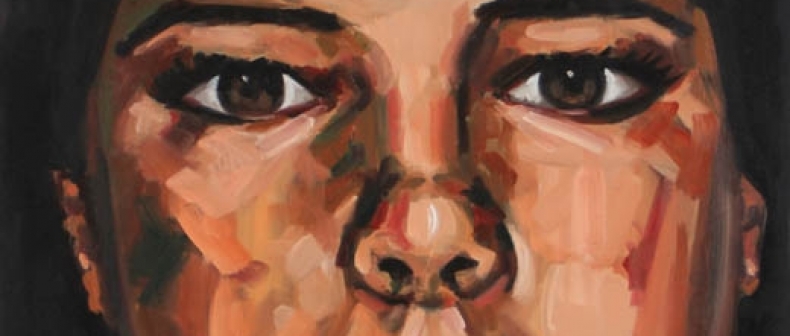
Photo Credit: Simon Farrington
Ilene Sova’s series, the Missing Women Project, gives a voice back to cases of missing women that have been forgotten and gone cold without ever reaching a final conclusion. Sova is a third-wave feminist and artist who discovered her medium of painting due to its history as a largely male-dominated activity, where female subjects were painted as sexual objects. “I think [painting] is an important medium to take over,” says Sova, “and to paint women, but from a woman’s perspective.”
Sova started thinking about Canadian statistics of violence against women in a prior series while painting women she knew. Many of these women in her circle had experienced violence and sexual assault, and Sova had also helped three friends get through and get out of abusive relationships during her time at university. “I had been wanting to do something in my work about [violence against women] and express how I was feeling about that, but I didn’t want to victim position the women,” shares Sova. “That’s already being done everywhere in the media. There are all these horror movies where women get chopped up and attacked, and even if you look in a fashion editorial the woman is positioned as a victim, not as a strong woman… I needed a way to do it, but showing them in a strong way or pleasant way, not in a victimized way.”
Amber PottsIt was while searching the OPP database of missing persons that Sova found her inspiration for the portraits she would come to paint. Along with each case description was a picture of the subject that would have been used in the news and on missing person notices. “These are snapshots and pictures of them from their yearbooks, when everything was great in their life,” explains Sova. “They’re smiling, and they’re the pictures that the families wanted to give to the police. They look good in them and they’re good representations of who they were.”
The next step for Sova’s project was to curtail the enormous pool of missing women she could pull from to paint. Her first move was to narrow down dates of the cases, for which Sova chose the years 1970 to 2000, and then she moved on to look for the ones that had been forgotten. The women in these portraits are not just missing from their homes, but also from the discourse. “There are all kinds of missing analogies in this,” adds Sova. The last factor in the search was diversity in terms of social class, race, and education, in order to break the myth that it’s just a certain type of woman who is in this kind of danger. “In the series there are very wealthy women, there are women who had mental illness, there are women who were runaways, there are women who were living that perfect pure life that society says we’re supposed to live – educated, white, living in the suburbs with their family – and still something happened,” says Sova.
Ilene Sova with her workAs the search for subjects to paint continued, Sova found disturbing patterns in how missing women are documented, mainly that women of colour are largely missing from databases. The next shock Sova experienced in her research was the recurrence of a clear hierarchy in Canada in which, from the perspective of the media and the police, one type of person has more value over another. “Women who were attractive and led what’s deemed ‘perfect lifestyles’ were all over the newspapers, then women who were mentally ill, or sex workers, or runaways have no currency in the media,” explains Sova. These discoveries opened Sova’s eyes to the discrimination found in our country that we often ignore or attribute to being other or elsewhere, but not here. In fact, in order to find information on missing aboriginal women, Sova had to go to a database outside of official services to Sisters in Spirit, which has been documenting such cases for years due to their lack of attention and documentation from the police.
Before these paintings of missing women went to hang in a public gallery, Sova was sure to contact as many families as possible in order to let them know about the project and give them the opportunity to voice their opinion on the matter. “If anybody said, ‘Oh, I’m not comfortable with that,’ I would take it out, but so far the families we’ve been able to reach have been amazing,” says Sova. “Because the cases are cold, they think maybe something will happen because of this, or it’ll be in the media and people will look at the case number and something will trigger in their mind, so they’re thankful for someone bringing light onto the case.” Many of the families will also be visiting the show to see the portrait of their loved one hanging amongst the faces of fellow missing women. Unfortunately, with some of the cases dating back to the early ‘70s, there have been families Sova has been unable to track down.
Elizabeth BainOf the 18 missing Ontario women Sova has painted portraits of, 3 are from the Greater Toronto Area: Amber Potts, Holly Painter, and Elizabeth Bain. Even just within this small sampling, the women represent different backgrounds, yet they all sadly met the same fate. Potts had a history as a runaway, Painter was adopted by her foster parents and had just successfully completed a six-month co-op with a local environmental group, and Bain graduated from University of Toronto Scarborough with a degree in psychology. None of these women were older than 22 and foul play is suspected in each case, with the boyfriend/male friend being the main suspect in the cases of Painter and Bain.
Bain’s case is particularly famous since Paul Bernardo came up as a potential suspect once her boyfriend had been acquitted. The details in Bain’s disappearance also differ from other cases in terms of the details. When Bain’s car was found three days after she went missing, there was enough blood in it that the police could declare her dead even without a body, as opposed to the question mark that lies after the names of the other 17 women in the Missing Women Project series. But like the other missing women, there has been no conviction in Bain’s case.
In Painter’s case, her story mirrors others in the group based on her male friend’s statement that she exited the car when it stopped at a light and ran off. “’She just jumped out of the car,’ that’s a common story,” explains Sova, “there are 3 women that just jumped out of the car. I’m like, ‘This again? This excuse again?’” Later, Painter’s male friend admitted to using her debit card across the border in New York State. This case in particular seems to be clear as to whom the guilty party is, but without a body or confession, nothing can be done by means of a conviction. “If you can create doubt in the mind of the jury, then the person will be acquitted,” says Sova.
Holly PainterWith the Missing Women Project, Sova hopes to incite discussion about the plight of missing women in Ontario, and Canada as a whole. Light needs to be shed on the fact that there are types of women that go overlooked, undocumented, and unvalued, and that all needs to change. “The way we’re documenting missing people is unorganized and kind of a mess,” says Sova. “It’s usually volunteers doing the work.”
Out of this project, Sova hopes to help better the system by filling in the blanks of the current databases. “My next phase will be to try and find the missing women of colour that are missing from these missing person databases,” shares Sova. Hopefully we can look forward to a day when the same attention is given to all cases as opposed to just the attractive ones, but for now Ilene Sova seems to be the sole crusader for these women whose voices have been taken away.
The Missing Women Project is on until March 19 at Creative Blueprint Gallery, 376 Bathurst Street.
____
Hallae Khosravi is an intern at Toronto Standard. Follow her on Twitter @hallaek.
For more, follow us on Twitter at @torontostandard and subscribe to our Newsletter.














